Chengdu is the capital of Sichuan Province, and most famous city for iconic Giant Pandas. It is also a vibrant city known for its rich history, cultural heritage, and modern development. With a history that spans over 2,300 years, Chengdu has evolved into a major economic hub and a melting pot of tradition and innovation. The city is famous for its relaxed lifestyle, spicy cuisine, and as the home of the giant panda. Chengdu’s blend of ancient culture and modern urban life makes it a fascinating destination for travelers.
In this Guide I will show you what to visit in Chengdu and near Chengdu.
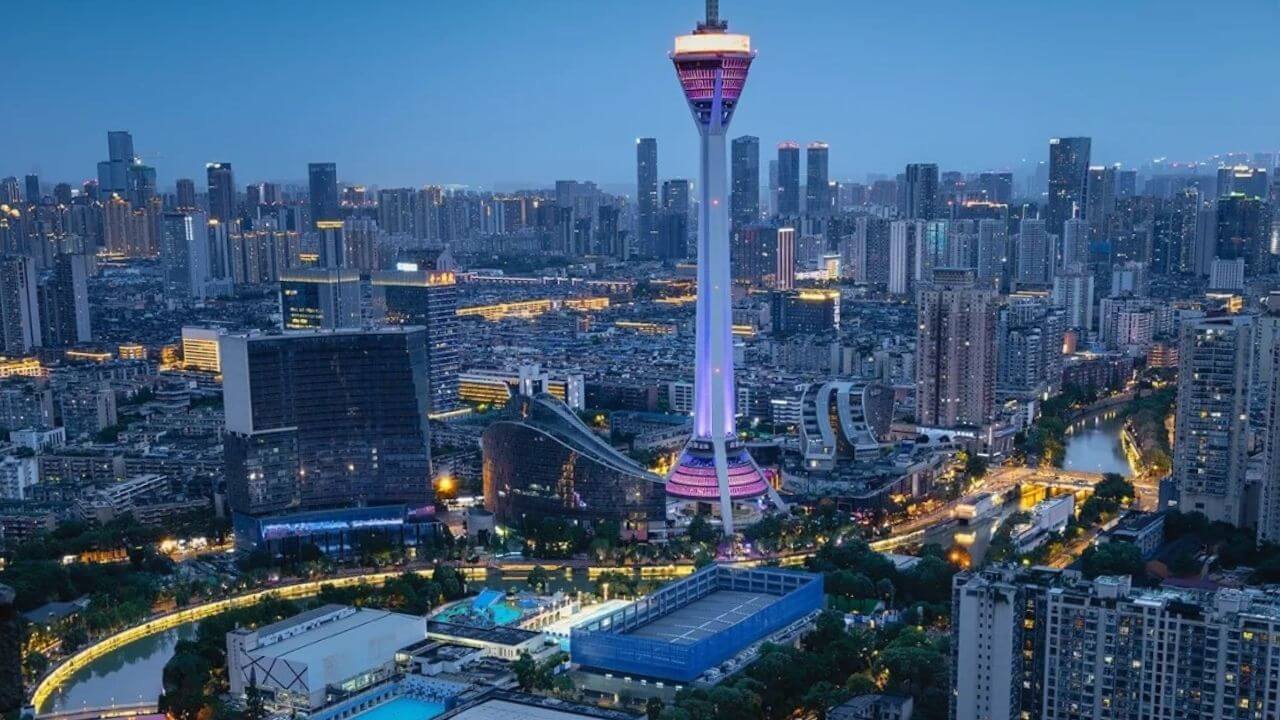
Chengdu is a city where the charm of ancient traditions meets the laid-back rhythm of modern life, all while being home to the beloved giant pandas.
Chengdu Research Base of Giant Panda Breeding
The Chengdu Research Base of Giant Panda Breeding is a world-renowned conservation and research facility dedicated to the protection and breeding of giant pandas. Established in 1987, the base is a leading center for panda conservation efforts, education, and tourism. It plays a crucial role in preserving the giant panda population and educating the public about these beloved creatures.
- Location: Chengdu, Sichuan Province, China
- Established: 1987
- Size: Over 100 hectares
- Species: Primarily giant pandas, but also red pandas, black-necked cranes, and other endangered species
- Mission: Conservation, breeding, research, education, and tourism
What you will see
Panda Enclosures
The base features spacious enclosures that mimic the pandas’ natural habitat, allowing visitors to observe them in a comfortable and natural setting. These enclosures house pandas of all ages, from playful cubs to mature adults.
Nursery and Cub Rooms
One of the highlights of visiting the base is the chance to see baby pandas in the nursery. The cub rooms offer a close-up view of the adorable young pandas as they play and interact with each other.
Panda Museum
The museum provides extensive information about giant pandas, their history, habitat, and conservation efforts. Exhibits include panda fossils, educational displays, and interactive multimedia presentations.
Giant Panda Kitchen
Visitors can learn about the specialized diet of giant pandas and see the preparation of their meals. The kitchen offers insight into the nutritional care and feeding practices for these unique animals.
Swan Lake
A beautiful area within the base featuring a serene lake, lush greenery, and various bird species. It’s a peaceful spot to relax and enjoy nature.
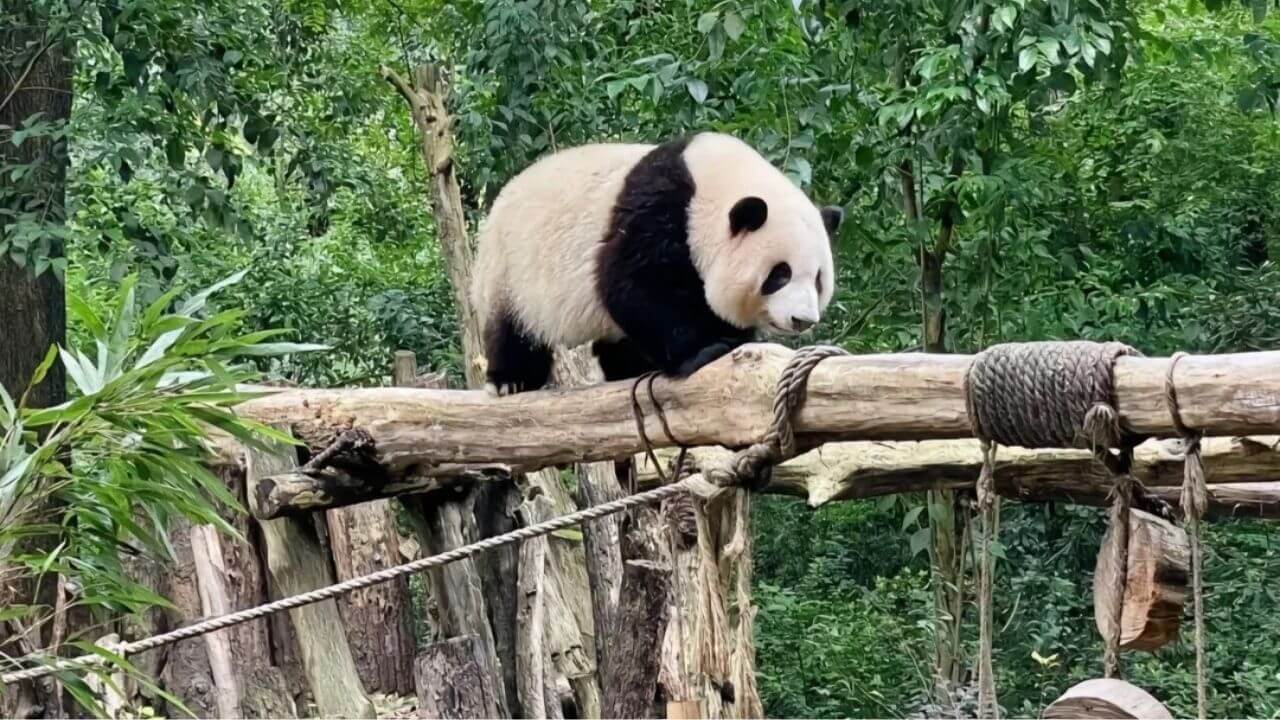
Tips for Visiting
- Best Time to Visit– Early morning is the best time to visit, as pandas are most active during this period. Plan to arrive when the base opens to avoid large crowds and to see the pandas during their feeding and playtime.
- Bring a Camera– The Chengdu Research Base of Giant Panda Breeding offers numerous photo opportunities. Be sure to bring a camera to capture the adorable pandas and beautiful scenery.
- Respect the Rules– Follow all guidelines and instructions provided by the staff. Maintain a respectful distance from the animals, and avoid making loud noises or using flash photography, which can disturb the pandas.
- Check the Weather– Chengdu’s weather can be unpredictable, so it’s a good idea to check the forecast before your visit. Bring appropriate clothing and gear, such as an umbrella or sunblock, depending on the season.
- Consider a Guided Tour– A guided tour can enhance your experience by providing in-depth information about the pandas and the base’s conservation efforts. Many tours are available in multiple languages.
Jinli Ancient Street
In the heart of Chengdu is Jinli Ancient Street. A busy and vibrant historical street that offers a glimpse into the rich cultural heritage of the region. With its roots dating back to the Qin Dynasty (221-206 BC), Jinli has been restored and transformed into a popular tourist destination, combining traditional architecture, local crafts, delicious food, and a lively atmosphere.
- Location: Wuhou District, Chengdu, Sichuan Province, China
- Historical Significance: Dates back to the Qin Dynasty
- Length: Approximately 550 meters
- Features: Traditional Sichuan architecture, shops, food stalls, cultural performances
What Tourists Like
Traditional Architecture:
The Wooden structures decorated with red lanterns, and carved facades makes Jinli Ancient Street worth visiting and enjoying the traditional Sichuan architectural style.
Local Crafts and Souvenirs:
The street is a haven for shoppers looking for unique and handmade crafts. Visitors can find a wide array of souvenirs, including silk products, traditional clothing, paper-cuttings, and intricate embroidery.
Sichuan Cuisine:
If you are food lover, then you must try local snacks on Junli Street. From spicy Sichuan hotpot to delicious street food like dandan noodles, dumplings, and sugar-coated fruits, there is something to satisfy every palate.
Cultural Performances:
Jinli Ancient Street often hosts cultural performances such as traditional Sichuan opera, folk music, and shadow puppetry. These performances provide an immersive experience of the local culture and entertainment.
Festive Atmosphere:
The street is especially vibrant during festivals and holidays, with decorations, lanterns, and special events adding to the lively atmosphere. The Chinese New Year and Mid-Autumn Festival are particularly festive times to visit.
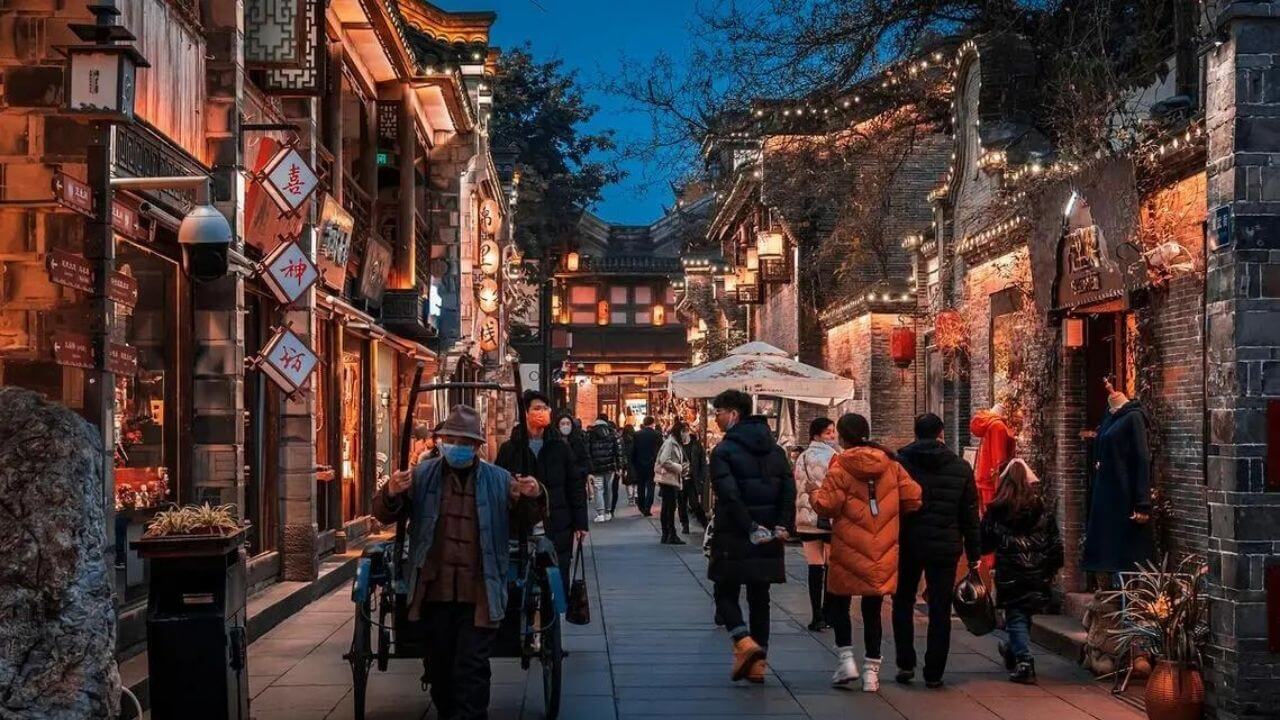
What to Do
Shopping for Souvenirs:
Explore the numerous shops and stalls to find unique souvenirs and gifts. Traditional handicrafts, tea sets, and calligraphy supplies are popular items to take home.
Strolling and Sightseeing:
Take a leisurely walk along Jinli Street to admire the traditional architecture and soak in the vibrant atmosphere. The street’s design and decorations provide excellent photo opportunities.
Visiting Wuhou Shrine:
Adjacent to Jinli Ancient Street is the Wuhou Shrine, dedicated to Zhuge Liang, a renowned strategist from the Three Kingdoms period. The shrine’s beautiful gardens and historical exhibits make it a worthwhile addition to your visit.
Tea House Experience:
Relax at one of the traditional tea houses along the street. Enjoy a cup of locally brewed tea while watching the bustling activities and enjoying the serene environment.
Wuhou Shrine (Wuhou Temple)
Wuhou Shrine, also known as Wuhou Temple, is a popular historical site located in Chengdu. It is dedicated to Zhuge Liang, the legendary military strategist and chancellor of the Shu Han state during the Three Kingdoms period. The temple complex is not only a place of worship but also a museum that offers insight into the rich history and culture of the Three Kingdoms era.
- Location: Wuhou District, Chengdu, Sichuan Province, China
- Historical Significance: Dedicated to Zhuge Liang (181–234 AD) and Liu Bei (161–223 AD), the emperor of Shu Han
- Established: Originally built in 223 AD, rebuilt during the Ming Dynasty (1368–1644)
- Area: Covers approximately 37,000 square meters
- Architectural Style: Traditional Chinese with beautiful gardens, pavilions, and statues
Historical and Cultural Significance:
Wuhou Shrine is rich in history, giving visitors a glimpse into the era of the Three Kingdoms. It honors Zhuge Liang, a symbol of wisdom and loyalty, and Liu Bei, the founder of the Shu Han state.
Architectural Beauty:
Everyone enjoys at the traditional Chinese architecture at Wuhou Temple. The mix of natural and man-made elements creates a calm and reflective atmosphere.
Exhibits and Artifacts:
Inside the shrine, you’ll find many artifacts such as stone tablets, statues, and historical relics from the Three Kingdoms period. Detailed exhibits tell stories about the lives and achievements of Zhuge Liang, Liu Bei, and other important figures.
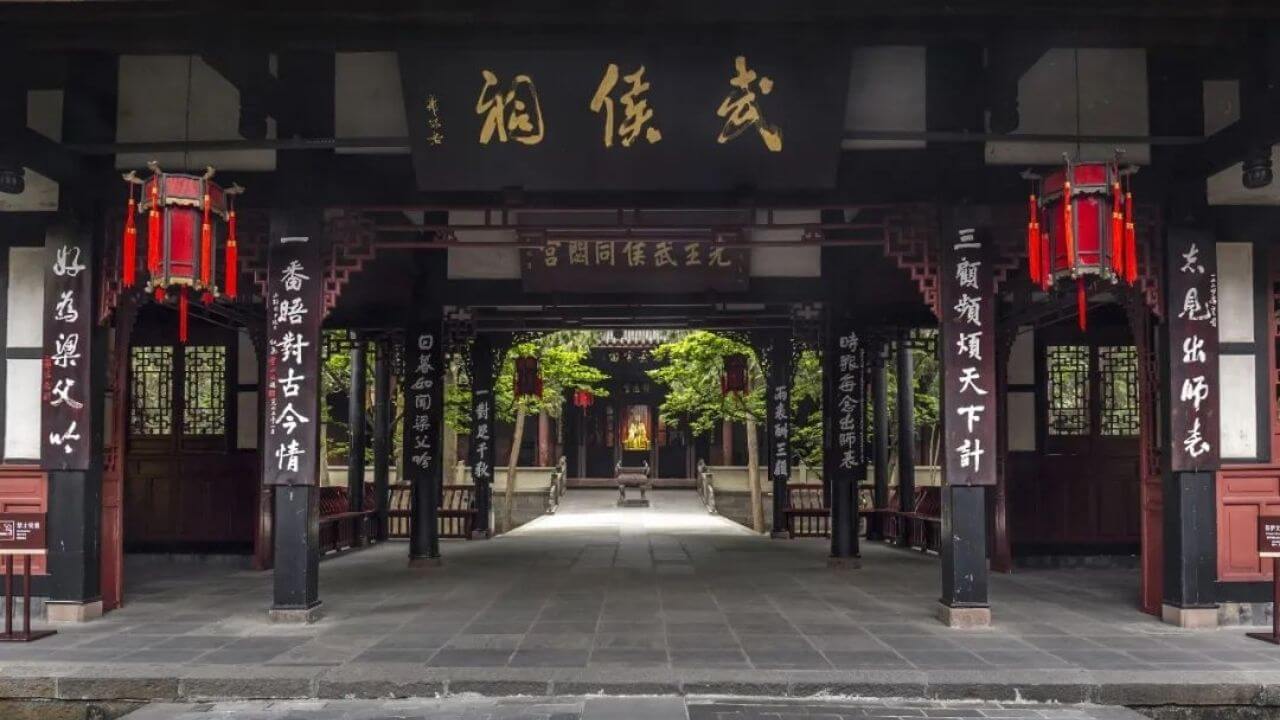
The Hall of Liu Bei:
This hall is dedicated to Liu Bei and features statues and memorials celebrating his legacy. Its intricate designs and historical importance make it a must-see for visitors.
The Hall of Zhuge Liang:
Another attraction that you can not miss is the Hall of Zhuge Liang, which honors the renowned strategist. It contains a statue of Zhuge Liang and various artifacts that highlight his contributions to Chinese history.
Scenic Gardens:
The temple’s gardens are beautifully landscaped with ponds, bridges, and a variety of plants and trees. Visitors can enjoy a peaceful walk through these gardens, appreciating the serene environment and traditional aesthetics.
Cultural Performances:
Occasionally, the temple hosts cultural performances and events showcasing traditional music, dance, and theatrical interpretations of historical tales from the Three Kingdoms period.
Educational Experience:
Information boards and guides throughout the temple provide valuable historical context, making a visit to Wuhou Shrine both educational and enriching. Many visitors leave with a deeper appreciation for Chinese history and culture.
Souvenir Shops:
At the end of your visit, explore souvenir shops offering a range of items related to the Three Kingdoms era, including books, replicas, and traditional crafts.
Chengdu People’s Park
Chengdu People’s Park, also known as Renmin Park, is a popular public park located in the heart of Chengdu. Established in 1911, this expansive urban park serves as a social and recreational hub for both locals and tourists.
- Location: Qingyang District, Chengdu, Sichuan Province
- Area: Approximately 112,639 square meters
- Features: Scenic gardens, artificial lake, historical monuments, tea houses, children’s playground, and cultural events
What you’ll see there
Scenic Landscapes:
In Chengdu People’s Park you can enjoy at lush greenery even you are at the heart of Chengdu. The perfectly maintained paths with mixture of greenery and the lake is a perfect escape of the busting city.
Heming Tea House:
If you are at Chengdu People’s Park you must have a tea at Heming Tea House. This traditional tea house offers a quintessential Chengdu experience where visitors can relax, sip tea, and observe the locals playing mahjong, chatting, and enjoying their time.
Historical Monuments:
The park is home to several historical monuments and memorials, including the Monument to the Martyrs of the Railway Protection Movement. These landmarks provide insight into Chengdu’s rich historical and cultural heritage.
Cultural Performances:
People’s Park often hosts cultural performances such as Sichuan opera, traditional music, and dance. These performances offer a glimpse into the local culture and provide entertaining experiences for visitors.
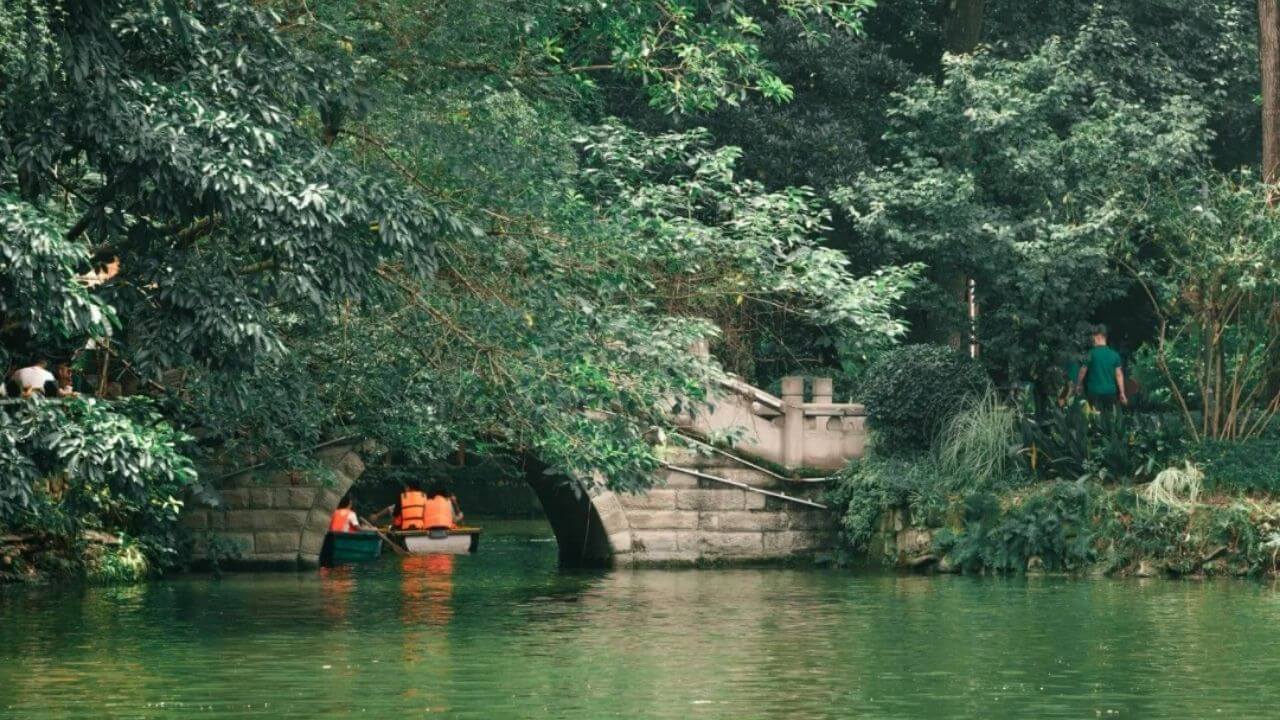
Children’s Playground:
The park features a dedicated area for children, complete with playground equipment and amusement rides. It’s an ideal spot for families to enjoy a day out with young ones.
Boat Rides:
The artificial lake within the park offers boat rentals, allowing visitors to paddle around and enjoy the serene water views. It’s a relaxing activity that provides a different perspective of the park’s beauty.
Fitness and Recreation:
Early mornings and evenings see locals practicing tai chi, dancing, and engaging in group exercises. If you are morning person you can join in or simply watch these activities to get a feel for the local lifestyle.
Seasonal Flower Exhibitions:
Throughout the year, the park hosts various flower exhibitions, including chrysanthemum shows and tulip displays. These events showcase the park’s horticultural beauty and attract numerous visitors.
Local Snacks and Street Food:
Within and around the park, visitors can find stalls and vendors selling local snacks and street food. Trying out these delicacies is a delightful way to experience Chengdu’s famous cuisine.
Photo Opportunities:
With its charming landscapes, traditional tea houses, and vibrant cultural activities, Chengdu People’s Park offers plenty of excellent photo opportunities. It’s a great place to capture memorable moments of your visit.
Mount Emei
One of the attractions that you must visit when you are in Chengdu is Mount Emei, also known as Emei Shan. Mout Emei is one of the Four Sacred Buddhist Mountains of China, and it is the highest of the four sacred mountains. Renowned for its rich cultural heritage, stunning natural scenery, and religious significance, Mount Emei has been a UNESCO World Heritage Site since 1996. The mountain is home to numerous temples and monasteries, making it a major pilgrimage site for Buddhists and a popular destination for tourists.
- Location: Emeishan City, Sichuan Province, China
- Height: 3,099 meters (10,167 feet)
- UNESCO World Heritage Site: Designated in 1996
- Significance: One of the Four Sacred Buddhist Mountains of China
- Main Attractions: Temples, monasteries, natural scenery, and the Giant Buddha of Leshan (nearby)
Why is worth visiting
Scenic Beauty:
Mount Emei is famous for its breathtaking natural scenery, including lush forests, cascading waterfalls, and panoramic views. The diverse flora and fauna, along with the ever-changing weather, create a mystical and serene environment.
Buddhist Temples and Monasteries:
The mountain is dotted with more than 30 temples and monasteries, each with its own unique history and architecture. Key temples include Baoguo Temple, Fuhu Temple, and Wannian Temple. These sacred sites are important places of worship and pilgrimage for Buddhists.
Golden Summit (Jinding):
The Golden Summit is one of the most popular attractions on Mount Emei. At an elevation of 3,077 meters, it offers spectacular views of the surrounding landscape, including the famous “Sea of Clouds.” The summit is also home to the massive bronze statue of Samantabhadra (Puxian) Bodhisattva.
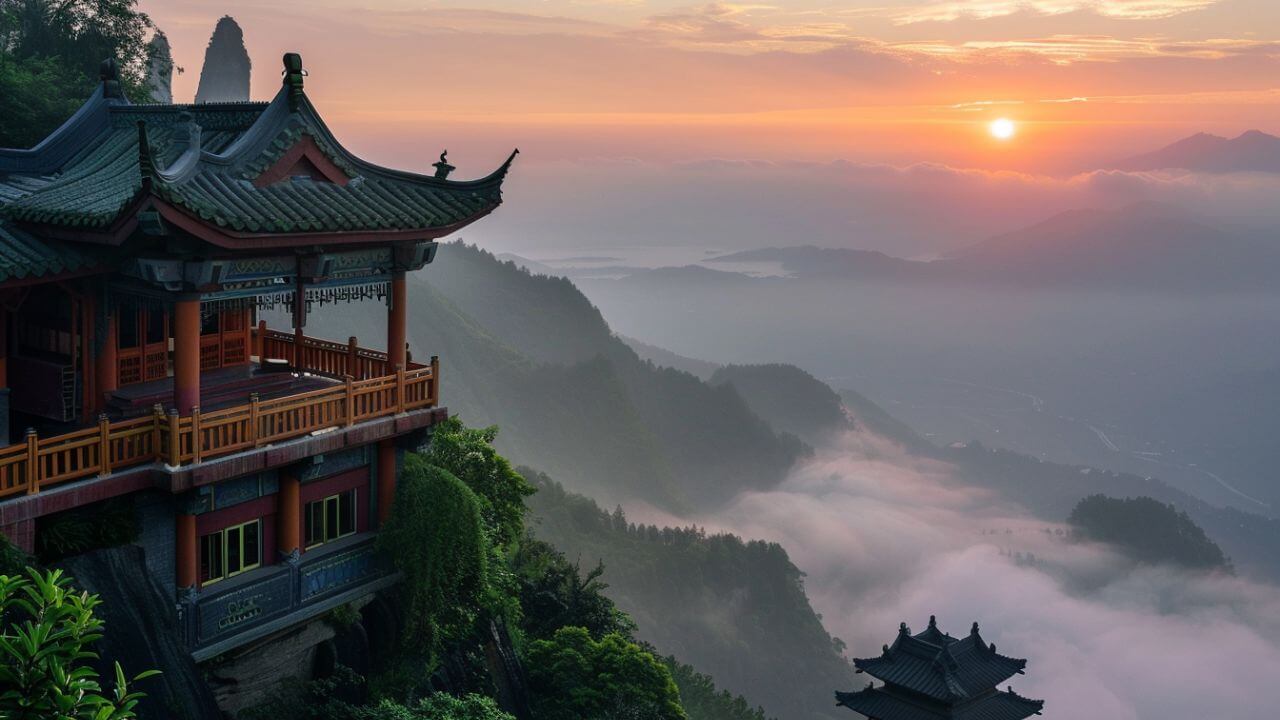
Hiking and Trekking:
Mount Emei offers a variety of hiking trails that cater to different levels of difficulty and fitness. The trails wind through dense forests, past ancient temples, and along scenic ridges. Hikers can enjoy the tranquility and natural beauty while exploring the mountain.
Wildlife Encounters:
The mountain is home to a diverse range of wildlife, including the endemic Emei Shan Liocichla, Tibetan macaques, and various bird species. Visitors may encounter these animals during their hikes, adding to the adventure and excitement.
Cable Car Rides:
For those who prefer a less strenuous way to explore the mountain, cable cars are available to take visitors to various points of interest, including the Golden Summit. The cable car rides offer stunning aerial views of the mountain’s landscape.
Cultural Performances:
Visitors can enjoy traditional cultural performances, such as Buddhist chanting, music, and dance, at some of the temples and monasteries. These performances provide a deeper understanding of the spiritual and cultural significance of the mountain.

Tips for Visiting
Best Time to Visit– are spring (April to May) and autumn (September to October), when the weather is mild and the scenery is at its most beautiful.
Wear Comfortable Clothing and Footwear– Hiking on Mount Emei requires comfortable clothing and sturdy footwear. Be prepared for varying weather conditions and bring layers to adjust to temperature changes.
Stay Hydrated and Bring Snacks– it’s important to stay hydrated and bring snacks to keep your energy levels up.
Respect the Local Culture and Traditions– As a significant religious site, it’s important to show respect for the local culture and traditions.
Plan for Accommodation– There are several hotels and guesthouses on Mount Emei and in the nearby town of Emeishan. Booking in advance is recommended, especially during peak tourist seasons.
The Leshan Grand Budhha
The Leshan Giant Buddha is a colossal stone statue carved into a cliff face in Leshan, Sichuan Province, China. Standing at 71 meters (233 feet) tall, it is the largest stone Buddha in the world. The statue depicts Maitreya, a future Buddha in Buddhist eschatology. Construction of the Buddha began in 713 AD during the Tang Dynasty and was completed in 803 AD. The site is a UNESCO World Heritage Site and a popular tourist attraction, drawing visitors from around the globe to marvel at its grandeur and historical significance.
- Location: Leshan, Sichuan Province, China
- Height: 71 meters (233 feet)
- Width: 28 meters (92 feet) shoulder-to-shoulder
- Construction Period: 713 AD to 803 AD
- Material: Stone
- Depiction: Maitreya (Future Buddha)
- UNESCO World Heritage Site: Designated in 1996
- Significance: Largest stone Buddha statue in the world
Reasons why visiting
Majestic Size and Scale
The Leshan Giant Buddha is impressive due to its enormous size. Standing next to it, visitors can truly appreciate the incredible engineering and artistry that went into its creation.
Scenic Location
The statue is situated where the Min River, Dadu River, and Qingyi River meet. This beautiful and tranquil setting is perfect for photography and relaxation.
Historical and Cultural Significance
The Leshan Giant Buddha has a rich history and is an important cultural symbol in China. Visitors can learn about its construction, the religious significance of Maitreya, and its cultural impact over the centuries.
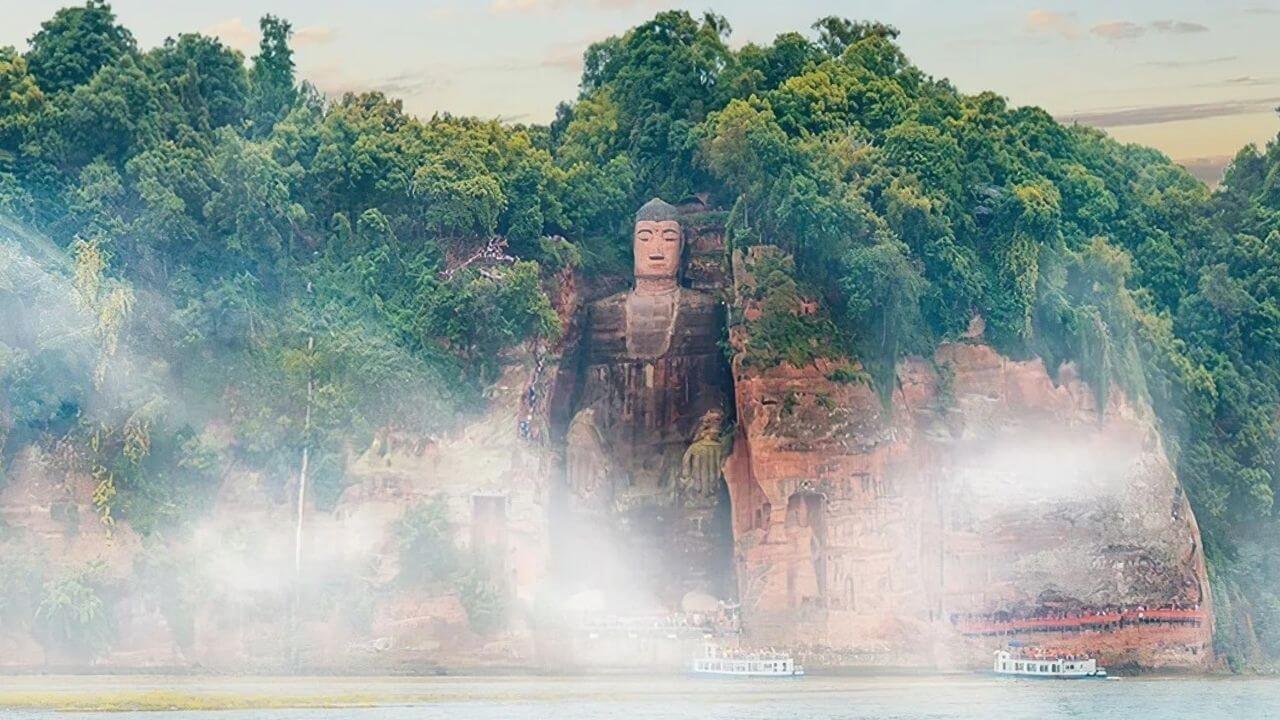
Buddhist Temples and Monasteries
Several temples and monasteries surround the Leshan Giant Buddha, including Lingyun Temple and Wuyou Temple. These sites offer insights into Buddhist practices and provide peaceful spots for meditation and reflection.
Viewing Platforms and Trails
There are multiple vantage points to view the Leshan Giant Buddha. Visitors can take a boat ride to see the statue from the river or walk along the trails and stairs for different perspectives of the statue and its surroundings.
Cultural Exhibits and Displays
The site features various exhibits and displays that provide information about the history, construction, and restoration of the Buddha. These educational elements enhance visitors’ understanding and appreciation of the statue’s significance.
Tips for Visiting
Best Time to Visit:- Spring (April to May) and autumn (September to October) when the weather is mild and the scenery is at its most beautiful.
Wear Comfortable Shoes– Be prepared for walking and climbing stairs.
Avoid Peak Hours– To avoid large crowds, try to visit early in the morning or later in the afternoon. Weekdays are generally less crowded than weekends.
Take a Boat Ride– Consider taking a boat ride on the river to get a different perspective of the Leshan Giant Buddha. The boat ride provides a full view of the statue from the water, offering unique photo opportunities.
Jiuzhai Valley National Park
Jiuzhai Valley National Park, also known as Jiuzhaigou, is a stunning nature reserve and national park located in the north of Sichuan Province and home of nine Tibetan villages. It is famous for its breathtaking landscapes, the park features multi-colored lakes, cascading waterfalls, snow-capped peaks, and dense forests. Jiuzhai Valley, which translates to “Nine Village Valley,” is named after the nine Tibetan villages scattered throughout the park. In 1992, it was designated a UNESCO World Heritage Site due to its exceptional natural beauty and ecological significance.
- Location: Aba Tibetan and Qiang Autonomous Prefecture, Sichuan Province, China
- Area: Approximately 720 square kilometers (278 square miles)
- UNESCO World Heritage Site: Designated in 1992
- Altitude: Ranges from 2,000 to 4,500 meters (6,600 to 14,800 feet)
- Flora and Fauna: Home to over 200 bird species, endangered animals like the giant panda and Sichuan golden snub-nosed monkey, and diverse plant life
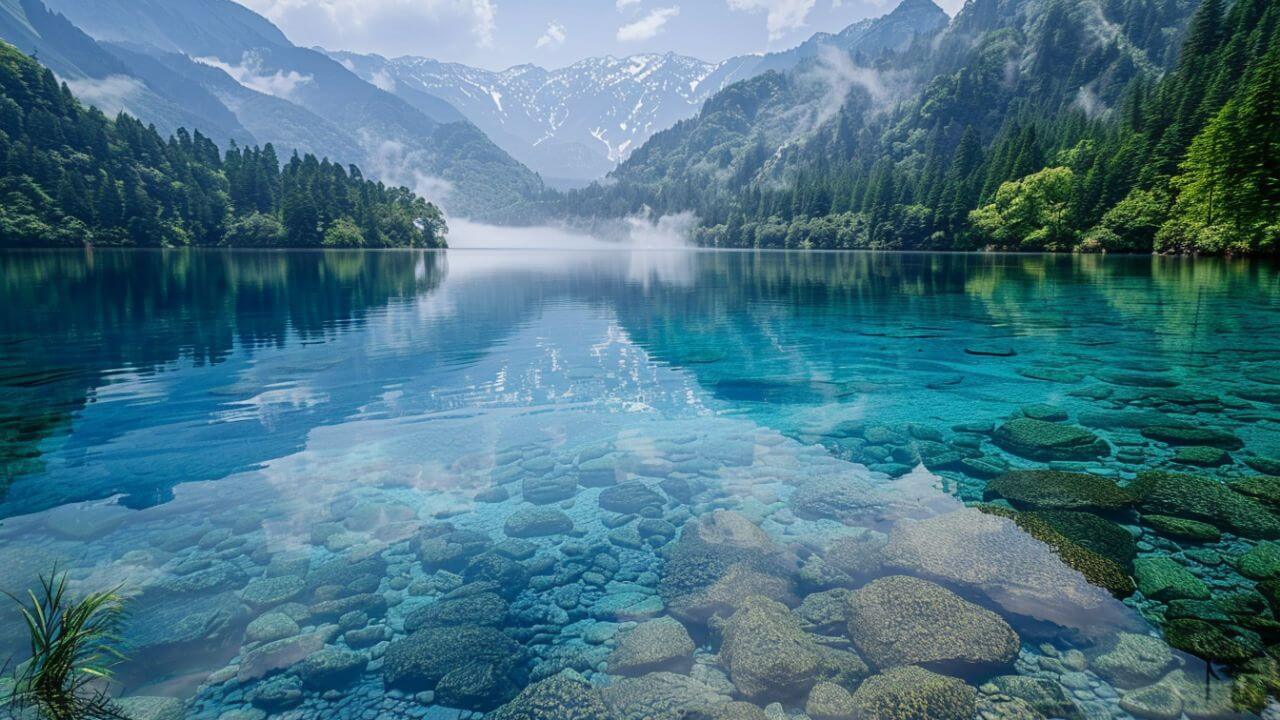
Why visit Jiuzhaigou
Spectacular Scenic Beauty:
Jiuzhai Valley National Park is known for its stunning natural scenery. Visitors can expect to see vibrant blue and green lakes, pristine rivers, dramatic waterfalls, and lush forests. The park’s picturesque landscapes change with the seasons, offering unique beauty year-round.
Multi-Colored Lakes:
The park is famous for its many beautiful lakes, each with its distinct color and clarity. Notable lakes include Five Flower Lake, which is known for its multi-colored waters, and Long Lake, the largest and deepest in the park.
Waterfalls and Streams:
Jiuzhai Valley is home to numerous waterfalls, including the impressive Nuorilang Waterfall, which is one of the widest in China. Other notable waterfalls include Pearl Shoal Waterfall and Panda Waterfall, each offering stunning views and photo opportunities.
Tibetan Villages:
Scattered throughout the park are nine Tibetan villages, which offer a glimpse into the traditional lifestyle and culture of the local Tibetan people. Visitors can explore these villages and learn about their customs, crafts, and way of life.
Rich Biodiversity:
The park’s diverse ecosystems support a wide variety of plant and animal species. Birdwatchers and nature enthusiasts can look forward to spotting rare birds and possibly even encountering endangered species like the giant panda in their natural habitat.
Seasonal Beauty:
Each season in Jiuzhai Valley brings its unique charm. In spring, wildflowers bloom, and the landscape is lush and green. Summer offers verdant forests and clear blue lakes. Autumn is particularly popular for its vibrant foliage, while winter transforms the park into a snowy wonderland.
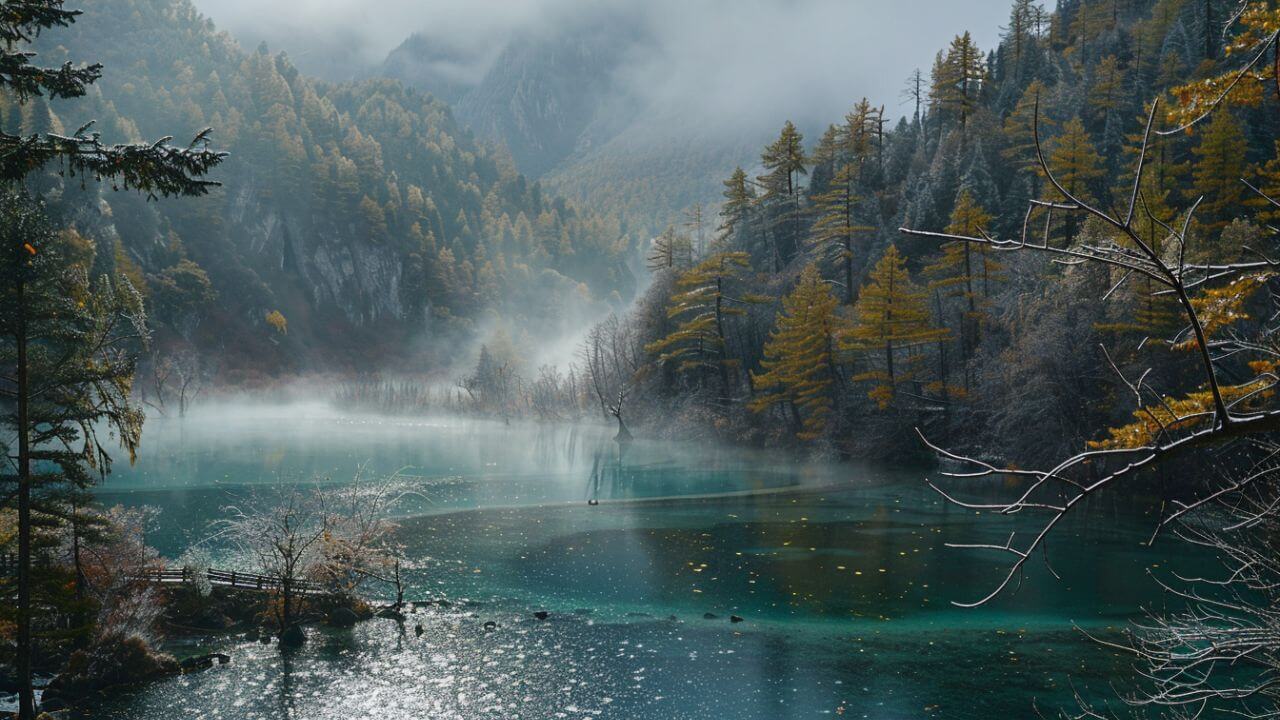
Tips for Visiting
Best Time to Visit– Spring (April to May) and autumn (September to November), when the weather is pleasant, and the scenery is at its most spectacular. Autumn is especially popular due to the stunning fall colors.
Prepare for Altitude– The park is located at high altitudes, so visitors should be prepared for the effects of altitude sickness. It’s advisable to acclimate gradually and stay hydrated.
Dress in Layers– Weather in the park can be unpredictable and vary significantly throughout the day. Dressing in layers allows you to adjust to changing temperatures and conditions.
Bring Comfortable Footwear– The park features extensive walking trails and boardwalks, so comfortable, sturdy footwear is essential for exploring the area.
Respect Local Culture– When visiting Tibetan villages and interacting with local residents, it’s important to be respectful of their customs and traditions. Ask for permission before taking photos of people or their homes.
Plan for Limited Facilities– While there are basic facilities like restrooms and food stalls within the park, amenities may be limited. It’s a good idea to bring snacks, water, and any other essentials you may need.

Helen Wang
Travel Advisor & Guide Expert
I started my travel career in 2005 and have since become an expert in Tibet and China’s travel destinations and helping travelers plan unforgettable trips.
For expert travel advice to China or Tibet, feel free to contact me.